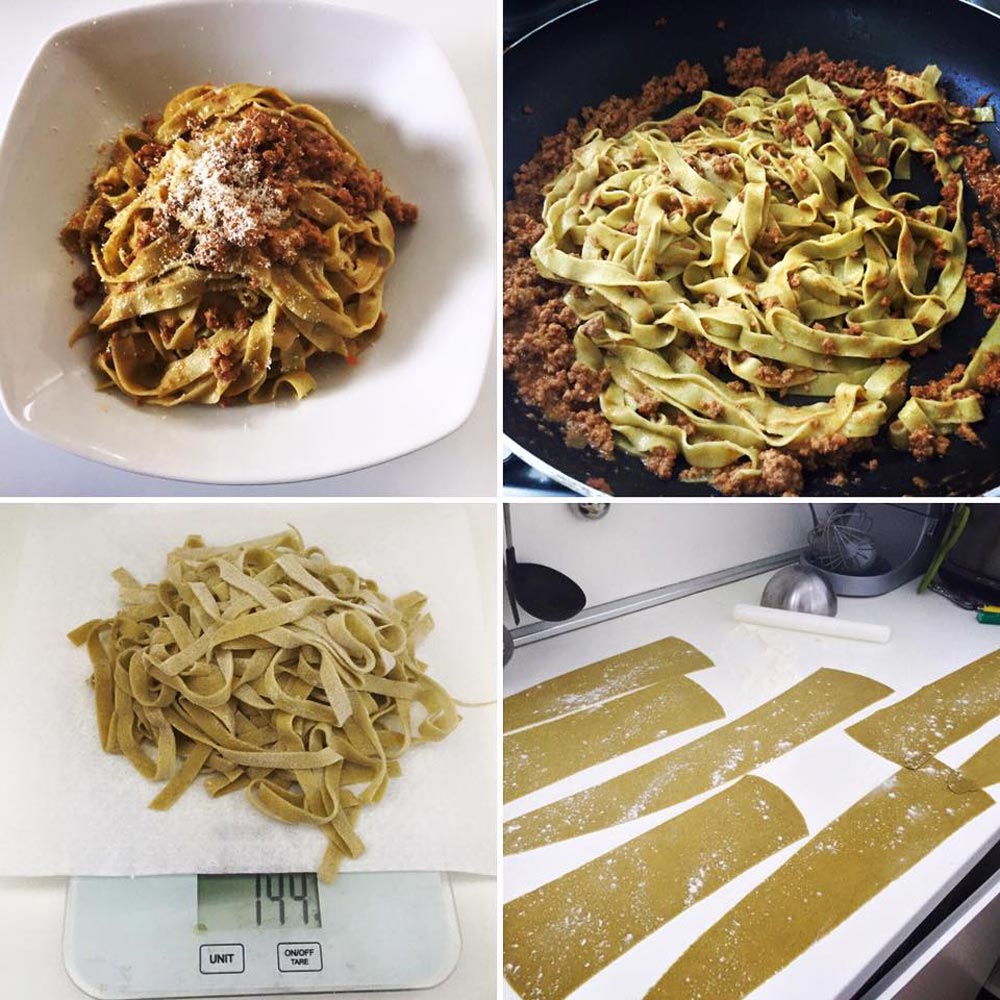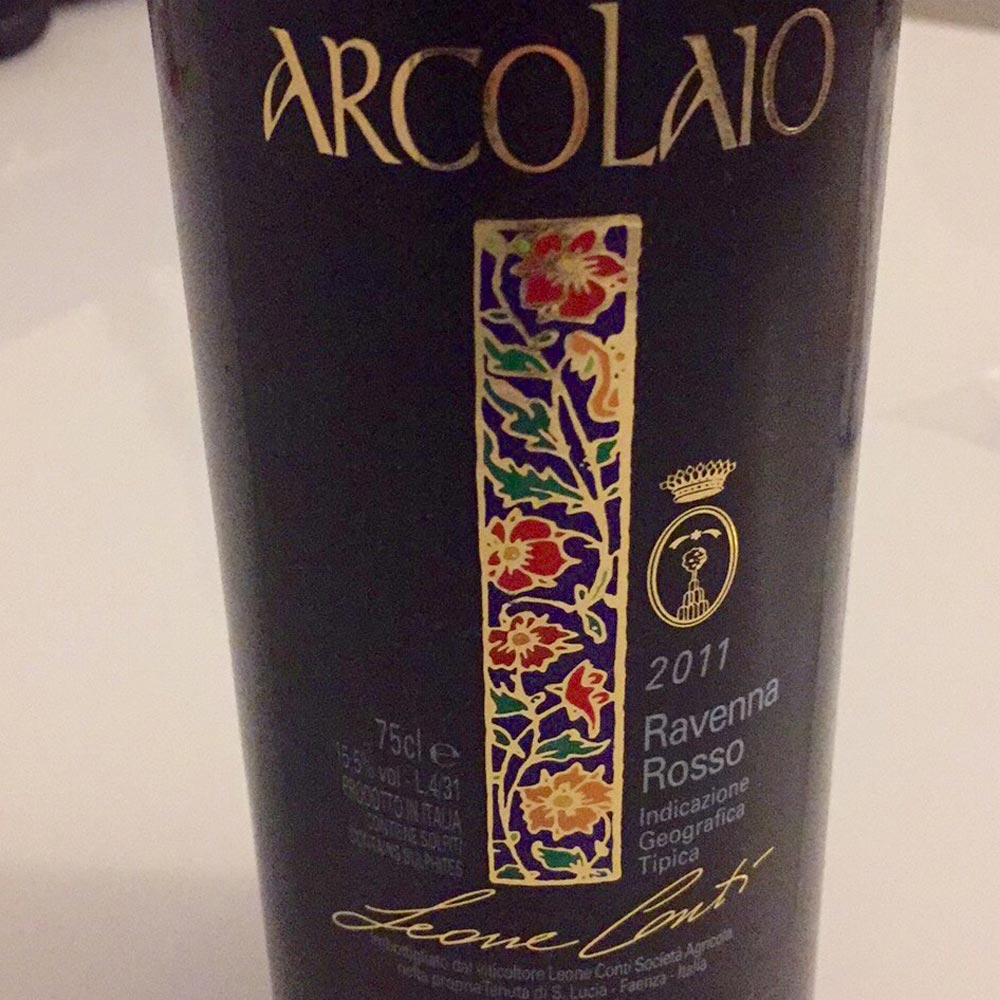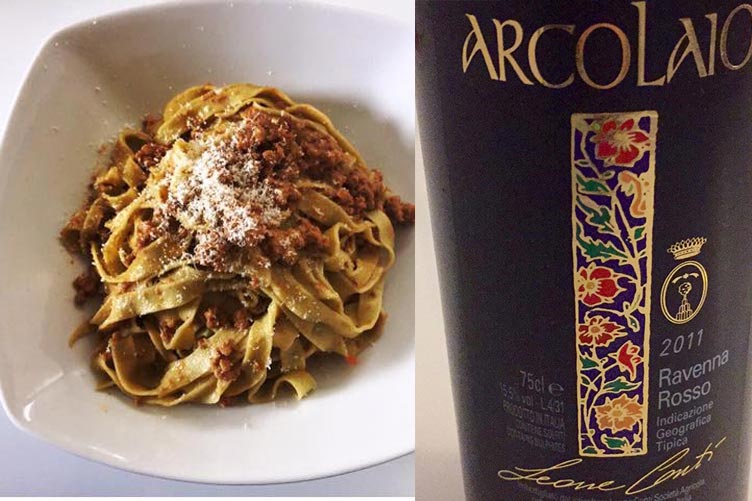Tonight I am writing to tell you about an indigenous grape variety of Romagna that I adore, the centesimo... and I am going to talk to you about it in combination with a dish that for me remains the king of my table: tagliatelle al ragù! I grew up with my beloved grandmother, and I have been making pasta since I was 5 years old... and we ate tagliatelle with meat sauce at least twice a week! In fact, it is the dish par excellence that I associate with my childhood... along with tortelloni filled with ricotta cheese and herbs in butter that we prepared every Thursday... or cappelletti in broth on Sundays... yes, it was a difficult childhood 😀

To make this recipe, assuming that like me you have a freezer full of single-portion tubs of meat sauce that I make once every 2 weeks, it takes very little time: 10 minutes to knead, 20 minutes to rest, 10 minutes to roll it out and cut it, and a scant 5 minutes to cook it! So in 35 minutes lunch is served!!! And in the meantime that the pasta is resting, you can thaw the meat sauce with a little hot water that you have put on the boil...
Finally, I want to make a point. Certainly there are many types of fine, organic flour, which I often have the pleasure of buying myself (for fresh pasta I actually use a very normal flour that I buy in the supermarket for convenience and pay 59 cents per kg). The special free-range eggs for pasta that I use cost 25 cents each, so 250 grams of fresh noodles cost me exactly 36 cents per 2 portions. Now, in a fresh pasta shop, noodles cost between 12 and 16 € per kg... and there is often water added to further reduce the cost. So let's say 250 grams costs you approximately €4. If, on the other hand, you buy dry (and not fresh) egg noodles at the supermarket, the average price is around 1.40 € for a medium quality pasta. The moral? #homemade cuisine is not only tastier and healthier, it is also good for our wallet 😉
Ingredients for the fresh pasta for 2 persons (250 g):
- 180 grams of 00 flour
- 2 special medium eggs for pasta (55 to 65 grams per egg)
- 1 heaping teaspoon of spinach flour (optional)
Noodle preparation:
I took the first part of the preparation from the my recipe for Casoncelli with butter, guanciale and sage and a beautiful Maurizio Zanella from Ca' del Bosco to match!
- Start preparing the puff pastry... forget about the pastry board, eggs in the fountain etc. etc... I don't like to dirty half the kitchen: it's practical! Then take a bowl large enough to hold the flour and 3 eggs (the pinch of salt takes up little room) and mix everything with a fork until the liquids are completely absorbed.
- Turn the mixture upside down (I use this handy silicone sheet I bought on amazon Silikomart food-grade silicone mat 60 X 40 cm
hygienic and very comfortable! There are many on sale for a few euros less... but they are generally smaller and therefore more uncomfortable! This one is really fantastic and of great quality... I even use it sometimes to bake instead of baking paper... unlike grandma's old chopping boards! This one you roll up and doesn't take up space, it's very smooth and doesn't line the fresh pasta and to clean it, you wash it under running water... it changed my life in the kitchen, I swear!) and knead until you get a smooth and compact loaf that isn't excessively hard, beating it to make it more elastic. Rinse and dry the bowl used earlier and tip it over the dough ball to let it rest 'indoors' for about 30 minutes. If you're lucky enough to have a boyfriend who gave you this beautiful Kenwood kneading machine for Christmas, just beat the eggs with the teaspoon of spinach flour, add the flour, and knead at a minimum first with the paddle attachment and then with the dough hook... about 10 minutes in all! Ah!!! I would like to point out that my beautiful Kenwood mixer is now at a discount on Amazon, from 500 € to 339 €... if you are thinking of buying a mixer this is the time to get it ? I can tell you that it works very well, it is quite silent, practical, solid and quite sturdy even if it vibrates a bit. But it has literally changed my life in the kitchen, I now make even more wonderful things! And especially for fresh pasta, which I make at home almost every day, it is very convenient! While she kneads, I can write on the blog! Here is the link to the Amazon offer!
- Take the dough and divide it into 2/3 pieces. You'll feel how much softer it is to work with. Take one piece and roll it out with a rolling pin... here's my secret, it's another fabulous piece from Silikomart... which isn't really an egg pasta rolling pin (it's supposedly made for sugarpaste) but it's absolutely perfect because it's super hygienic, washes out in a second and non-stick (so the dough doesn't stick to it). I bought it on amazon together with the mat, here's the link Silikomart, Matterello, 40 cm
yes, I know, the purists of the wooden rolling pin are shuddering... but I don't want to be a desperate housewife ?
- Roll out the dough with the Marcato Ampia 150 pasta machine
I bought it at the Coop in Ravenna... and I paid 45 €... so I can't tell you how nervous I was when I saw it on Amazon for 38 € -.-" (of course there's the shipping... but if you buy a few more items the shipping is free or at least you amortise it and it's really convenient!) I love this machine because it takes up very little space and I clean it super fast with a damp sponge. I get up to grade 6 thickness on this machine. I recommend dusting with a little flour between each pass! Once the dough is rolled out (with these doses I get 2 sheets that I cut into 4 with a pizza wheel like this one, I cut the dough in the slit of my Marcato Ampia 150 pasta machineI dust with flour and shake the noodles to make sure they don't stick and throw them into boiling salted water.
- When the noodles come to the surface, I let them boil for about a minute and transfer them to the pan with meat sauce, a knob of butter and about 50 grams of grated Parmesan cheese. I saute for a couple of minutes... and the noodles are ready:

As you can see, the ragout in the photo is a bit dry! That's because I used very little fat because I'm trying to diet a bit! But I'll give you the recipe for my real ragù, the good fat one... that if you try it once you won't eat ragù anywhere else 😀
In every house in Romagna everyone has their own way of preparing ragù... this is my family's recipe!
Ingredients for lots and lots of meat sauce (I make about 10 single-portion boxes plus 4 boxes for two people and 2 boxes for 4 people... plenty!):
- 1 kg of chopped beef;
- 500 g pork mince;
- 200 g sausage paste;
- 1 carrot, 1 celery stalk, 1 onion;
- 50 g of lard (at home there is always some to make piadina romagnola);
- 1 tube of double tomato paste;
- 1 glass of milk;
- 1 glass of sangiovese di romagna;
- salt and nutmeg;
- 2 litres of broth (I use 2 knorr broth hearts, 1 vegetable and 1 beef)
Preparation:
- mince carrot, celery and onion and fry in lard;
- add the meat and let it brown;
- add the glass of red wine and let it fade for a few minutes;
- mix half a tube of tomato paste with half a glass of water then add it;
- add 2 ladlefuls of stock and leave to cook for about 30 minutes, then add the glass of milk and leave to cook for about 4 hours, stirring and adding a ladleful of stock from time to time. Season with salt and plenty of nutmeg.
When it is ready you will see the fat on the surface perfectly separated from the meat on the bottom. When you portion it, be careful to put some of its fat in each tin.
If you want a more unusual combination than Sangiovese di Romagna, I propose an indigenous black, semi-aromatic grape variety from the Faenza and Ravenna hills. The particular name of the vine is in honour of the first vine grower who started its cultivation, Pietro Pianori, known as Centesimino. The scions for grafting are said to have been taken from a long-lived vine that survived phylloxera thanks to its position within the walls of an 18th-century noble residence. It is said that these vines arrived in Romagna from Spain, and this thesis seems to be supported by the fact that there are vines called Alicante del Faentino that were cultivated together with Savignòn Rosso. From a series of analyses comparing Centesimino with the other Alicante del Faentino and Alicante vines (Cannonau, Tocai Rosso and Grenache), it was discovered that it had a different profile from these but was the same as the common Cesanese, Ciliegiolo, Montepulciano and Moscato di Scanzo (and others whose names I cannot remember). Then there were new analyses of the vine's DNA and it was definitively established that it was a new species and it was duly registered! In short, as the winegrower told me, the first Centesimino wines were produced in the mid-1990s and currently only eight wineries in the provinces of Ravenna and Forlì-Cesena (plus a few very small private winegrowers) produce it for a total of just over 40,000 bottles per year!

I chose this Centesimino 'Arcolaio' by Leone Conti because for me it is its finest expression. Harvested by hand, it evolves in barrique for 24 months and is refined for 10 months in the bottle. Although it exceeds 15°, its softness and enveloping qualities make it a great drink. On the nose, scents of dog rose, vanilla and morello cherry, in the mouth great intensity, balance and persistence. With my tagliatelle al ragù it was an exciting combination.
Let me know if you try the recipe!!!
See you soon,
Chiara

